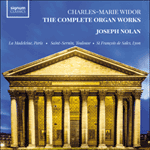
Welcome to Hyperion Records, an independent British classical label devoted to presenting high-quality recordings of music of all styles and from all periods from the twelfth century to the twenty-first.
Hyperion offers both CDs, and downloads in a number of formats. The site is also available in several languages.
Please use the dropdown buttons to set your preferred options, or use the checkbox to accept the defaults.

The minore first movement is a single-dotted-rhythm ‘French overture’ Toccata with florid interjections characteristic of the type. The second, also in the minor, is a four-part Fugue in 6/8 on a subject related to the gigue from Bach’s Third English Suite. Mendelssohn shadows the third and fourth chapters—a winning ‘song without words’ in A flat major, redolent of that master’s Op 19 No 4, played at Widor’s funeral (absent from the first edition); and (likewise added only in 1887) a nimbly semiquavered Scherzo in C minor (pianissimo staccato) with a common-time trio (in accompanied two-part canonic/imitative counterpoint) which serves also as a coda. The fifth movement, again in A flat, is stylistically a pastorale—on the one hand memorable for its voix humaines emphases and variations of detail (for instance, the harmonic enrichment and added pedal notes of the reprise); on the other striking for the key swings of the central section. The coda, at the end echoing of the close of the third movement, could not be more beautifully placed or proportioned. The maggiore Finale is a sonata-rondo on a 3/4 quasi-’martial’ refrain alla Schumann. Primary and secondary harmonisation contrasts with unexpected tonal event in the reprise following the triplefied D minor middle episode, the modified refrain reinforcing B flat and D flat rather than the tonic of expected convention. When F major is finally reached, it’s thundered home in appropriately ringing glory, full organ ablaze. ‘Grandeur,’ Widor used tell his students, ‘is the organ’s essential characteristic. This is because, of all musical instruments, [it] can sustain sound indefinitely and with the same intensity’.
from notes by Ateş Orga © 2013
 Widor: The Complete Organ Works Widor: The Complete Organ WorksRecorded on the Cavaillé-Coll organs (Symphonies 1-9 at La Madeleine, the other works in Toulouse and Lyon) so beloved of Widor, Joseph Nolan's mammoth survey represents an ideal marriage of composer, instrument and performer: 'Nolan’s combination ...» More |

